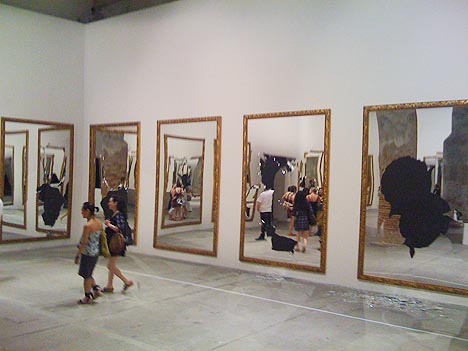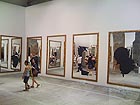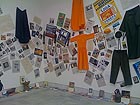
translated and summarized by: Liz Wollner-Grandville,
English Summary June 7 - 14
La Biennale di Venezia: 53. Venice Biennale - Arsenale
A dignified art-promenade
The audience is guided into a time machine. But in which direction is it leading them? At first to the classics. In the dimness of the Arsenale, an amazing intervention based on the concept of the Brazilian Lygia Pape, who passed away in 2004, astounds the onlooker. The geometrically braced wiring creates the effect light rays penetrating from outside. The concept of reconstructing the three-dimensional work is outstanding. The perfectly balanced lighting transcends the materiality. The art room distances itself from the outside hectic; the Leitmotiv for “Fare Mondi / Making Worlds”. Similar to the Giardini - Palazzo delle Esposizione, curator Daniel Birnbaum offers diverse representational systems.
Then: a series of broken mirrors in portrait mode, classically framed: Michelangelo Pistoletto. Twisting of the topic “light” combined with identity. On the opposite side, a section with drawings by the Slovenian artist and urbanist Marjetica Potrc displaying sketched suggestions for interventions and alternative architecture in crisis-ridden areas and economically precarious living situations. The sequence is puzzling. but on the other hand, the unusual juxtaposition reminds of Pistoletto’s phase of socio-economic criticism. Nevertheless, Birnbaum’s focus is not easily decoded. One of the main motives behind the selection seems to be based on the attempt to stage varying formalisation strategies with serial or repeated moments; or at least trying to channel the view into this direction. This reminds of Peter Greenaway’s strategies as director, artist, and curator to reveal grammars. And on the other hand there is tendency to re-auratize the renovated halls of the Arsenale. Compared to earlier exhibitions at the Arsenale, Birnbaum loosens up the mode of presentation. It is no longer a compact exhibition parcours, but more of a ventilated art promenade with numerous classic positions of contemporary art. One makes extremely interesting encounters while strolling through the exhibit. Yona Friedmanns’s or Carsten Höller’s visual translations of architectural transfer-situations or the videos by the Italian artist Grazia Toderi, leading into the orbit of nocturnal urban landscapes viewed from an infinite distance. The interventions by the young Cameroonian artist Pascale Marthine Tayou seem to liberate the Arsenale’s somewhat strict classification system. In his large format installation he offers an architectural mix of an African village combined with integrated video installations and references to various cultural citations and symbols of the global world. And this is where sentimentality kicks in. Following the obsessive and excessive exhibitions by Harald Szemann or the exhibition “Less Aesthetics More Ethics” shown at the seventh Architectural Biennial in these halls, it gradually becomes apparent that the individual positions are able to prove their quality and some sections of the exhibition even stimulate a debate. But all in all, the entire enterprise lacks the character of a clear statement. The readiness to experiment, surprise, or maybe even provoke, is lacking. The opportunity to make a lasting mark with a large scale Biennial exhibit is neglected. Instead, this is simply a routine job done well.
By Roland Schöny
La Biennale di Venezia – Arsenale
30122 Venezia, until 22.11.09
www.labiennale.org
La Biennale di Venezia: 53. Venice Biennale – Italian Pavilion
Inventing worlds without history
The widespread medial popularity of the Venice Bienniale is remarkable. Maybe even understandable. Curator Daniel Birnbaum makes clear indications in the direction of a comprehensive consensus project. His exhibition at the Arsenale and the former Italian Pavilion in the Giardini successfully avoids the critical reflection, although the selected positions could tell another story.
Obviously “Fare Mondi / Making Worlds” refers to late 20th century discursive developments, to Fluxus, to post minimalistic movements or to art forms, that take up a direct dialogue with urban developments, such as Gordon Matta Clark’s interventions. Even hints on dimensions of performative manifestations, such as André Cadarés’ interventions, to which an exiting exhibition in Bucharest was devoted last year, can be discovered.
But Cadarés colourfully painted bars (Barres de bois rond), which he utilized as mobile markings beyond art venues in the 1970s, look lost. And Öyvind Fahlströms fabulous map transformations come across as somewhat incidental. And this does not only pertain to his works. Other presentations also seem subdued or torn out of their context. By referring to specific “worlds”, constituted during the course of artistic production in accordance with the motto of the exhibition, Birnbaum points to a central way of comprehension, but mediates this as an anthropological constant. He thereby directs the view to visual, grammatical systems, something that is definitely legitimate, but at the same time he marginalizes a significant component: the critical global reference.
Other exhibitions in the past were successful in doing so: the NGBK Berlin with the project “Political / Minimal” last year and Cathrin David’s documenta X, with works by Öyvind Fahlström and Gordon Matta Clark. Daniel Birnbaum as the renowned editor, art historian, and Academy director, chose the approach of a skilful art-diplomat.
In addition, hardly anyone worked with the lighting in the former Italian pavilion. Maybe that is the reason why George Adéagbo’s presentation comes across as sterile; just as reserved as the art-anarchist Tony Conrad’s film paintings. Refreshing on the other hand one of the few videos that Birnbaum decided to integrate: Dominique Gonzalez Foerster presenting an ironic view on the invitation procedure and the adventurous production circumstances in Venice.
By Roland Schöny
La Biennale die Venezia
30122 Venezia, Giardini della Biennale, until 22. 11. 09
www.labiennale.org
La Biennale di Venezia: 53. Venice Biennale – Austrian Pavilion
Something’s fermenting
The outer encroachments and ingredients are very subtle: the temporary new outbuilding by Franziska and Lois Weinberger on the left of the pavilion conceals – critically questioning the Giardini and the pavilion system – a slowly transforming compost heap in its interior. In the middle of the pavilion the view to the interior court is irritated by an artfully positioned white installation, part of the Dorit Margreiter installation “Pavilion”, placed there by the architect Gabu Heindl to centre the otherwise visually baseless tree through shifting the centre line towards the right. And the German word “TABU” attached to the outside façade of the space installation “TABOU TABOO” by Elke Krystufek in the interior pretends to be a different name for Austria.
This time the Austrian Pavilion had two commissioners, Valie Export and Silvia Eiblmayer, who selected three – Austrian – positions. The Weinbergers added a selection of earlier works to their olfactory sensational and poetic new work “Laubreise” (foliage journey) – quasi the museum juxtaposed to the fermenting contemporary art. Dorit Margreiter shot a black-and-white film in the Josef Hoffmann building in the Giardini, constructed in 1934, and thereby delved into this architectural sculpture. The performance of two women in this multilayered film is a reference to the fact that this pavilion was once a utopian exhibition space for painting and sculptures. The “Pavilion” screening room, designed by Gabu Heindl, itself is a sculptural “Grey Room”: a passageway forming an open movie room, in which the camera movements are projected throughout the empty building. Elke Krystufek’s installation of drawings and sketches, as well as a video based on conversations held at art openings, deals with social taboos: the heterosexual female view of the male body, by which she consequently substitutes the to this day still dominant male view of the female body.
Choosing three such renowned positions seemed to be a safe bet. But the concept didn’t quite work out. Collectively they are too compact and intensive, and compete against each other. Admittedly, one would not want to miss any of these three Biennial installations, but less would have been more.
By Andrea Winklbauer
La Biennale di Venezia
30122 Venezia, Giardini della Biennale, until 22.11.09
www.labiennale.org
Camera Austria: Then the work takes place – On the paradigm of the conceptual in contemporary photography
Picture language
As a continuation of the exploration of conceptual tendencies in photography, which go beyond documenting conceptual work and develop new formal as well as aesthetic approaches, the current exhibition at the Camera Austria completes Dan Graham’s dictum to Sol LeWitt. In the relationship between idea and work the focus shifted to the work, and artists were selected, who subtly undermine the classic conceptual classification system. The fact that all of these deliberations are the cause for overlaps can partly be attributed to the artists Joachim Koester and Peter Piller, both present at the exhibit, and who were also already present in 2006.
Marine Hugonnier’s work “Towards Tomorrow (International Date Line, Alaska I)”, 2001, impresses with its size and the popular as well as kitschy sunset-motif. And only the title sheds light on the actual meaning of her work: the view goes towards tomorrow, the next day, across the dateline, by showing a sundown and thereby disturbing the human cognition automatism.
Sharon Lockhart’s triptych deals with seeing and being seen. One of the employees at the Oaxaca section of the Anthropological Museum in Mexico City is transformed into an “object on display”, but by returning the glances back to the viewer he escapes objectification.
This exhibition can be considered a silent homage to Bas Jan Ader whose complete dedication to artistic articulation of conceptual processes, for which he paid with his life, is continuously explicitly implicit (Jean-Luc Mylayne), implied (Hans Schabus) or immanent (Christopher Williams).
Even if this exhibition seems to be demanding for the viewer, the pictures speak for themselves – and are appealing -, but it is up to the viewer to which extent he/she wants to deal with the underlying concept.
By Nora Theiss
Camera Austria
8020 Graz, Kunsthaus Graz, Lendkai 1, until 28.06.09
www.camera-austria.at
Mehr Texte von translated and summarized by: Liz Wollner-Grandville


 Teilen
Teilen





